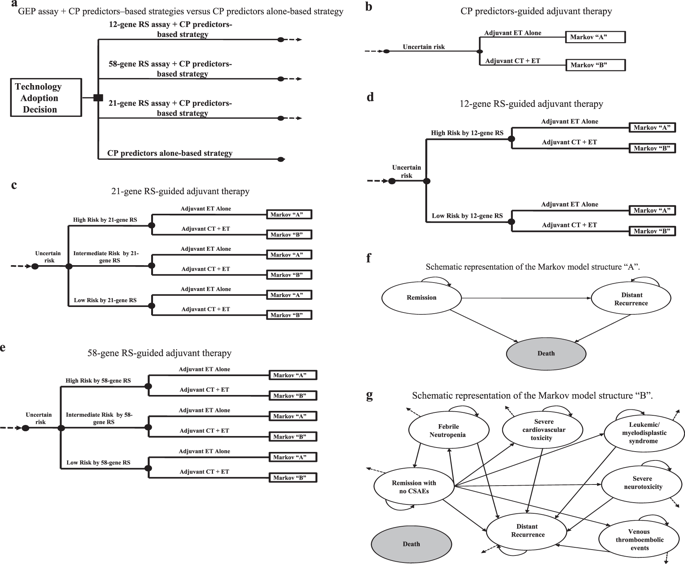当前位置:
X-MOL 学术
›
Pharmacogenomics J.
›
论文详情
Our official English website, www.x-mol.net, welcomes your
feedback! (Note: you will need to create a separate account there.)
Cost-effectiveness analysis of multigene expression profiling assays to guide adjuvant therapy decisions in women with invasive early-stage breast cancer.
The Pharmacogenomics Journal ( IF 2.9 ) Pub Date : 2019-05-27 , DOI: 10.1038/s41397-019-0089-x Malek B Hannouf 1 , Gregory S Zaric 2, 3 , Phillip Blanchette 4 , Christine Brezden-Masley 5, 6 , Mike Paulden 7 , Christopher McCabe 8, 9 , Jacques Raphael 4 , Muriel Brackstone 1, 4
The Pharmacogenomics Journal ( IF 2.9 ) Pub Date : 2019-05-27 , DOI: 10.1038/s41397-019-0089-x Malek B Hannouf 1 , Gregory S Zaric 2, 3 , Phillip Blanchette 4 , Christine Brezden-Masley 5, 6 , Mike Paulden 7 , Christopher McCabe 8, 9 , Jacques Raphael 4 , Muriel Brackstone 1, 4
Affiliation

|
Gene expression profiling (GEP) testing using 12-gene recurrence score (RS) assay (EndoPredict®), 58-gene RS assay (Prosigna®), and 21-gene RS assay (Oncotype DX®) is available to aid in chemotherapy decision-making when traditional clinicopathological predictors are insufficient to accurately determine recurrence risk in women with axillary lymph node-negative, hormone receptor-positive, and human epidermal growth factor-receptor 2-negative early-stage breast cancer. We examined the cost-effectiveness of incorporating these assays into standard practice. A decision model was built to project lifetime clinical and economic consequences of different adjuvant treatment-guiding strategies. The model was parameterized using follow-up data from a secondary analysis of the Anastrozole or Tamoxifen Alone or Combined randomized trial, cost data (2017 Canadian dollars) from the London Regional Cancer Program (Canada) and secondary Canadian sources. The 12-gene, 58-gene, and 21-gene RS assays were associated with cost-effectiveness ratios of $36,274, $48,525, and $74,911/quality-adjusted life year (QALY) gained and resulted in total gains of 379, 284.3, and 189.5 QALYs/year and total budgets of $12.9, $14.2, and $16.6 million/year, respectively. The total expected-value of perfect information about GEP assays' utility was $10.4 million/year. GEP testing using any of these assays is likely clinically and economically attractive. The 12-gene and 58-gene RS assays may improve the cost-effectiveness of GEP testing and offer higher value for money, although prospective evidence is still needed. Comparative field evaluations of GEP assays in real-world practice are associated with a large societal benefit and warranted to determine the optimal and most cost-effective assay for routine use.
中文翻译:

多基因表达谱分析的成本效益分析,以指导浸润性早期乳腺癌女性的辅助治疗决策。
可使用 12 基因复发评分 (RS) 测定 (EndoPredict®)、58 基因 RS 测定 (Prosigna®) 和 21 基因 RS 测定 (Oncotype DX®) 进行基因表达谱 (GEP) 测试,以帮助做出化疗决策-当传统的临床病理学预测指标不足以准确确定腋窝淋巴结阴性、激素受体阳性和人表皮生长因子受体 2 阴性早期乳腺癌女性的复发风险时。我们检查了将这些检测纳入标准实践的成本效益。建立了一个决策模型来预测不同辅助治疗指导策略的终生临床和经济后果。该模型使用来自阿那曲唑或他莫昔芬单独或联合随机试验的二次分析的后续数据进行参数化,来自伦敦地区癌症计划(加拿大)和加拿大二级来源的成本数据(2017 加元)。12 基因、58 基因和 21 基因 RS 检测的成本效益比分别为 36,274 美元、48,525 美元和 74,911 美元/质量调整生命年 (QALY),总收益分别为 379、284.3 和189.5 QALY/年,总预算分别为 12.9 美元、14.2 美元和 1660 万美元/年。关于 GEP 检测实用性的完美信息的总预期价值为 1040 万美元/年。使用任何这些测定法的 GEP 测试可能在临床和经济上都具有吸引力。12 基因和 58 基因 RS 检测可能会提高 GEP 检测的成本效益并提供更高的性价比,但仍需要前瞻性证据。
更新日期:2019-11-18
中文翻译:

多基因表达谱分析的成本效益分析,以指导浸润性早期乳腺癌女性的辅助治疗决策。
可使用 12 基因复发评分 (RS) 测定 (EndoPredict®)、58 基因 RS 测定 (Prosigna®) 和 21 基因 RS 测定 (Oncotype DX®) 进行基因表达谱 (GEP) 测试,以帮助做出化疗决策-当传统的临床病理学预测指标不足以准确确定腋窝淋巴结阴性、激素受体阳性和人表皮生长因子受体 2 阴性早期乳腺癌女性的复发风险时。我们检查了将这些检测纳入标准实践的成本效益。建立了一个决策模型来预测不同辅助治疗指导策略的终生临床和经济后果。该模型使用来自阿那曲唑或他莫昔芬单独或联合随机试验的二次分析的后续数据进行参数化,来自伦敦地区癌症计划(加拿大)和加拿大二级来源的成本数据(2017 加元)。12 基因、58 基因和 21 基因 RS 检测的成本效益比分别为 36,274 美元、48,525 美元和 74,911 美元/质量调整生命年 (QALY),总收益分别为 379、284.3 和189.5 QALY/年,总预算分别为 12.9 美元、14.2 美元和 1660 万美元/年。关于 GEP 检测实用性的完美信息的总预期价值为 1040 万美元/年。使用任何这些测定法的 GEP 测试可能在临床和经济上都具有吸引力。12 基因和 58 基因 RS 检测可能会提高 GEP 检测的成本效益并提供更高的性价比,但仍需要前瞻性证据。











































 京公网安备 11010802027423号
京公网安备 11010802027423号